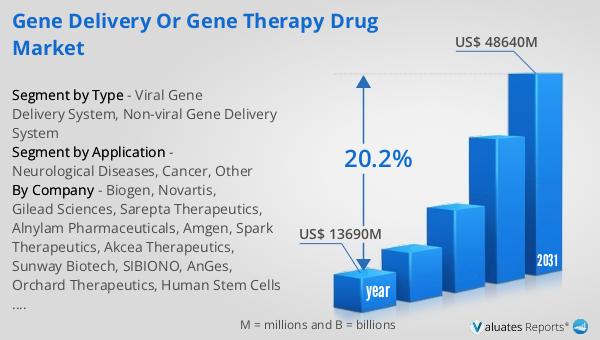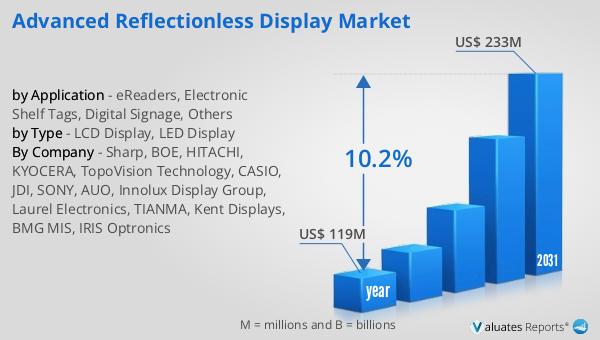What is Global Gene Delivery or Gene Therapy Drug Market?
Global Gene Delivery or Gene Therapy Drug Market refers to the rapidly evolving field of medicine that focuses on the development and application of treatments that modify or manipulate the expression of genes to treat or prevent diseases. This market is driven by the increasing prevalence of genetic disorders and chronic diseases, advancements in gene editing technologies, and growing investments in research and development. Gene therapy involves the introduction, removal, or alteration of genetic material within a patient's cells to treat a specific disease. The market encompasses various delivery systems, including viral and non-viral methods, to ensure the therapeutic genes reach the target cells effectively. As the understanding of genetic diseases improves and technology advances, the potential for gene therapy to provide long-lasting and potentially curative treatments is becoming increasingly promising. The market is characterized by a diverse range of applications, from treating rare genetic disorders to more common conditions like cancer and neurological diseases. The global gene therapy market is poised for significant growth as more therapies receive regulatory approval and become commercially available, offering new hope to patients worldwide.

Viral Gene Delivery System, Non-viral Gene Delivery System in the Global Gene Delivery or Gene Therapy Drug Market:
The Viral Gene Delivery System is a cornerstone of the Global Gene Delivery or Gene Therapy Drug Market. This system utilizes modified viruses as vectors to deliver therapeutic genes into target cells. Viruses are naturally adept at entering cells and delivering genetic material, making them effective tools for gene therapy. Commonly used viral vectors include adenoviruses, adeno-associated viruses (AAV), lentiviruses, and retroviruses. Each type of virus has unique properties that make it suitable for different therapeutic applications. For instance, AAVs are favored for their ability to infect both dividing and non-dividing cells and their low immunogenicity, making them ideal for long-term gene expression. Lentiviruses, on the other hand, are capable of integrating into the host genome, providing stable and long-lasting gene expression, which is particularly useful for treating chronic conditions. However, the use of viral vectors is not without challenges. There are concerns about the potential for immune responses, insertional mutagenesis, and the limited capacity of some viral vectors to carry large genes. Despite these challenges, viral gene delivery systems remain a dominant force in the gene therapy market due to their efficiency and effectiveness in delivering therapeutic genes. In contrast, Non-viral Gene Delivery Systems offer an alternative approach that circumvents some of the limitations associated with viral vectors. These systems include physical methods like electroporation, where an electrical field is applied to cells to increase permeability and facilitate gene uptake, and chemical methods such as the use of liposomes or nanoparticles to encapsulate and deliver genetic material. Non-viral methods are generally considered safer as they pose a lower risk of immune responses and insertional mutagenesis. They also offer greater flexibility in terms of the size of the genetic material that can be delivered. However, non-viral systems often face challenges related to lower efficiency in gene transfer and transient expression of the therapeutic gene. Despite these hurdles, ongoing research and technological advancements are enhancing the efficacy and stability of non-viral delivery methods, making them increasingly viable options in the gene therapy landscape. The choice between viral and non-viral gene delivery systems depends on various factors, including the specific disease being targeted, the required duration of gene expression, and the patient's individual characteristics. As the Global Gene Delivery or Gene Therapy Drug Market continues to expand, both viral and non-viral systems are expected to play crucial roles in the development of innovative therapies. The integration of advanced technologies such as CRISPR-Cas9 gene editing with these delivery systems is further propelling the market forward, offering new possibilities for precise and effective treatments. The ongoing research and collaboration among scientists, clinicians, and industry stakeholders are essential in overcoming the existing challenges and unlocking the full potential of gene therapy to transform the treatment landscape for a wide range of diseases.
Neurological Diseases, Cancer, Other in the Global Gene Delivery or Gene Therapy Drug Market:
The Global Gene Delivery or Gene Therapy Drug Market is making significant strides in the treatment of various diseases, including neurological disorders, cancer, and other conditions. In the realm of neurological diseases, gene therapy offers promising solutions for conditions that have been traditionally difficult to treat. For example, in diseases like Parkinson's and Huntington's, where specific neurons are affected, gene therapy can be used to deliver genes that produce neuroprotective proteins or restore the function of defective genes. This approach has the potential to slow disease progression and improve the quality of life for patients. Additionally, gene therapy is being explored for its potential to treat genetic forms of epilepsy and amyotrophic lateral sclerosis (ALS), offering new hope for patients with these debilitating conditions. In the field of cancer, gene therapy is being utilized to develop innovative treatments that target the genetic mutations driving tumor growth. One of the most promising applications is the use of CAR-T cell therapy, where a patient's T cells are genetically modified to recognize and attack cancer cells. This approach has shown remarkable success in treating certain types of blood cancers, such as leukemia and lymphoma. Gene therapy is also being explored to enhance the effectiveness of existing cancer treatments, such as chemotherapy and radiation, by sensitizing cancer cells to these therapies or by protecting healthy cells from their harmful effects. The ability to target specific genetic alterations in tumors offers the potential for more personalized and effective cancer treatments. Beyond neurological diseases and cancer, the Global Gene Delivery or Gene Therapy Drug Market is also addressing a wide range of other conditions. For instance, gene therapy is being used to treat inherited retinal diseases, offering the possibility of restoring vision in patients with conditions like Leber congenital amaurosis. In the realm of cardiovascular diseases, gene therapy is being explored to promote the regeneration of heart tissue and improve heart function in patients with heart failure. Additionally, gene therapy holds promise for treating rare genetic disorders, such as cystic fibrosis and hemophilia, by correcting the underlying genetic defects. The versatility of gene therapy in addressing diverse medical needs underscores its potential to revolutionize the treatment landscape across multiple therapeutic areas. As research and development efforts continue to advance, the Global Gene Delivery or Gene Therapy Drug Market is poised to deliver transformative therapies that address unmet medical needs and improve patient outcomes.
Global Gene Delivery or Gene Therapy Drug Market Outlook:
The global market for Gene Delivery or Gene Therapy Drugs was valued at approximately $13.69 billion in 2024. This market is anticipated to experience substantial growth, reaching an estimated value of $48.64 billion by 2031. This impressive expansion is driven by a compound annual growth rate (CAGR) of 20.2% over the forecast period. The significant growth in this market can be attributed to several factors, including advancements in gene editing technologies, increased investment in research and development, and a growing understanding of genetic diseases. As more gene therapies receive regulatory approval and become commercially available, the market is expected to expand further, offering new treatment options for patients with a wide range of medical conditions. The increasing prevalence of genetic disorders and chronic diseases is also contributing to the rising demand for gene therapy solutions. As the market continues to evolve, it is poised to play a crucial role in transforming the treatment landscape for various diseases, providing patients with innovative and potentially curative therapies. The projected growth of the Global Gene Delivery or Gene Therapy Drug Market highlights the immense potential of this field to address unmet medical needs and improve patient outcomes worldwide.
| Report Metric | Details |
| Report Name | Gene Delivery or Gene Therapy Drug Market |
| Accounted market size in year | US$ 13690 million |
| Forecasted market size in 2031 | US$ 48640 million |
| CAGR | 20.2% |
| Base Year | year |
| Forecasted years | 2025 - 2031 |
| Segment by Type |
|
| Segment by Application |
|
| By Region |
|
| By Company | Biogen, Novartis, Gilead Sciences, Sarepta Therapeutics, Alnylam Pharmaceuticals, Amgen, Spark Therapeutics, Akcea Therapeutics, Sunway Biotech, SIBIONO, AnGes, Orchard Therapeutics, Human Stem Cells Institute |
| Forecast units | USD million in value |
| Report coverage | Revenue and volume forecast, company share, competitive landscape, growth factors and trends |
